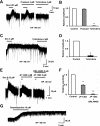Action of dexmedetomidine on the substantia gelatinosa neurons of the rat spinal cord
- PMID: 18554299
- PMCID: PMC2658019
- DOI: 10.1111/j.1460-9568.2008.06260.x
Action of dexmedetomidine on the substantia gelatinosa neurons of the rat spinal cord
Abstract
Dexmedetomidine is a highly specific, potent and selective alpha(2)-adrenoceptor agonist. Although intrathecal and epidural administration of dexmedetomidine has been found to produce analgesia, whether this analgesia results from an effect on spinal cord substantia gelatinosa (SG) neurons remains unclear. Here, we investigated the effects of dexmedetomidine on postsynaptic transmission in SG neurons of rat spinal cord slices using the whole-cell patch-clamp technique. In 92% of the SG neurons examined (n = 84), bath-applied dexmedetomidine induced outward currents at -70 mV in a concentration-dependent manner, with the value of effective concentration producing a half-maximal response (0.62 microM). The outward currents induced by dexmedetomidine were suppressed by the alpha(2)-adrenoceptor antagonist yohimbine, but not by prazosin, an alpha(1)-, alpha(2B)- and alpha(2C)-adrenoceptor antagonist. Moreover, the dexmedetomidine-induced currents were partially suppressed by the alpha(2C)-adrenoceptor antagonist JP-1302, while simultaneous application of JP-1302 and the alpha(2A)-adrenoceptor antagonist BRL44408 abolished the current completely. The action of dexmedetomidine was mimicked by the alpha(2A)-adrenoceptor agonist oxymetazoline. Plots of the current-voltage relationship revealed a reversal potential at around -86 mV. Dexmedetomidine-induced currents were blocked by the addition of GDP-beta-S [guanosine-5'-O-(2-thiodiphosphate)] or Cs+ to the pipette solution. These findings suggest that dexmedetomidine hyperpolarizes the membrane potentials of SG neurons by G-protein-mediated activation of K+ channels through alpha(2A)- and alpha(2C)-adrenoceptors. This action of dexmedetomidine might contribute, at least in part, to its antinociceptive action in the spinal cord.
Figures





Similar articles
-
Actions of noradrenaline on substantia gelatinosa neurones in the rat spinal cord revealed by in vivo patch recording.J Physiol. 2004 Mar 1;555(Pt 2):515-26. doi: 10.1113/jphysiol.2003.054932. Epub 2003 Dec 12. J Physiol. 2004. PMID: 14673188 Free PMC article.
-
Action of neuropeptide Y on nociceptive transmission in substantia gelatinosa of the adult rat spinal dorsal horn.Neuroscience. 2005;134(2):595-604. doi: 10.1016/j.neuroscience.2005.04.045. Neuroscience. 2005. PMID: 15975724
-
Effects of endomorphin on substantia gelatinosa neurons in rat spinal cord slices.Br J Pharmacol. 2003 Nov;140(6):1088-96. doi: 10.1038/sj.bjp.0705534. Epub 2003 Oct 6. Br J Pharmacol. 2003. PMID: 14530213 Free PMC article.
-
A novel slow excitatory postsynaptic current in substantia gelatinosa neurons of the rat spinal cord in vitro.Neuroscience. 1997 Feb;76(3):673-88. doi: 10.1016/s0306-4522(96)00291-6. Neuroscience. 1997. PMID: 9135042
-
Opioid-activated postsynaptic, inward rectifying potassium currents in whole cell recordings in substantia gelatinosa neurons.J Neurophysiol. 1998 Dec;80(6):2954-62. doi: 10.1152/jn.1998.80.6.2954. J Neurophysiol. 1998. PMID: 9862898
Cited by
-
Evaluation of the Adjuvant Effect of Dexmedetomidine on Ropivacaine for Transversus Abdominis Plane Block in Inguinal Hernia Repair: A Prospective Double-Blind Randomized Trial.J Clin Med. 2025 Apr 4;14(7):2478. doi: 10.3390/jcm14072478. J Clin Med. 2025. PMID: 40217927 Free PMC article.
-
High-Dose Dexmedetomidine Promotes Apoptosis in Fetal Rat Hippocampal Neurons.Drug Des Devel Ther. 2021 Jun 8;15:2433-2444. doi: 10.2147/DDDT.S300247. eCollection 2021. Drug Des Devel Ther. 2021. PMID: 34135573 Free PMC article.
-
Isobaric ropivacaine with or without dexmedetomidine for surgery of neck femur fracture under subarachnoid block.J Anaesthesiol Clin Pharmacol. 2018 Oct-Dec;34(4):518-523. doi: 10.4103/joacp.JOACP_226_18. J Anaesthesiol Clin Pharmacol. 2018. PMID: 30774234 Free PMC article.
-
A comparison of efficacy of parenteral and perineural dexmedetomidine with 0.25% ropivacaine for post-thyroidectomy analgesia using bilateral superficial cervical plexus block.J Anaesthesiol Clin Pharmacol. 2023 Jan-Mar;39(1):98-105. doi: 10.4103/joacp.joacp_177_21. Epub 2023 Feb 2. J Anaesthesiol Clin Pharmacol. 2023. PMID: 37250248 Free PMC article.
-
Incidence of bradycardia in pediatric patients receiving dexmedetomidine anesthesia: a meta-analysis.Int J Clin Pharm. 2017 Feb;39(1):139-147. doi: 10.1007/s11096-016-0411-5. Epub 2016 Dec 31. Int J Clin Pharm. 2017. PMID: 28040841 Review.
References
-
- Aho M, Erkola O, Kallio A, Scheinin H, Korttila K. Dexmedetomidine infusion for maintenance of anesthesia in patients undergoing abdominal hysterectomy. Anesth. Analg. 1992;75:940–946. - PubMed
-
- Anzai Y, Nishikawa T. Thoracic epidural clonidine and morphine for postoperative pain relief. Can. J. Anaesth. 1995;42:292–297. - PubMed
-
- Asano T, Dohi S, Ohta S, Shimonaka H, Iida H. Antinociception by epidural and systemic alpha(2)-adrenoceptor agonists and their binding affinity in rat spinal cord and brain. Anesth. Analg. 2000;90:400–407. - PubMed
-
- Baba H, Shimoji K, Yoshimura M. Norepinephrine facilitates inhibitory transmission in substantia gelatinosa of adult rat spinal cord (part 1): effects on axon terminals of GABAergic and glycinergic neurons. Anesthesiology. 2000;92:473–484. - PubMed
-
- But AK, Ozgul U, Erdil F, Gulhas N, Toprak HI, Durmus M, Ersoy MO. The effects of pre-operative dexmedetomidine infusion on hemodynamics in patients with pulmonary hypertension undergoing mitral valve replacement surgery. Acta Anaesthesiol. Scand. 2006;50:1207–1212. - PubMed
Publication types
MeSH terms
Substances
LinkOut - more resources
Full Text Sources
Other Literature Sources
Medical

